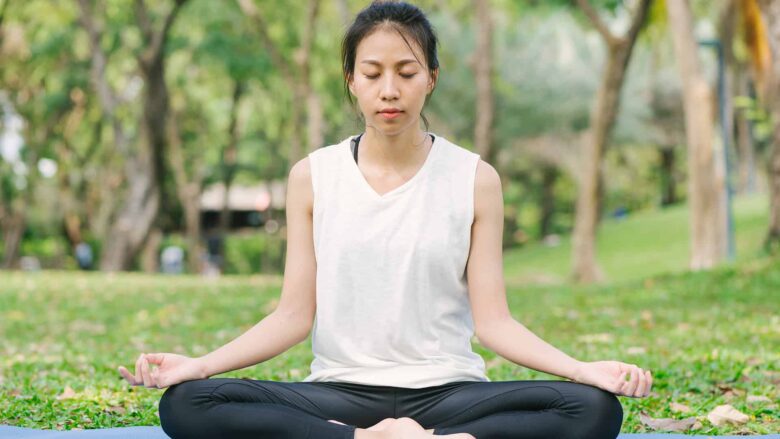Mindfulness practiced daily can help to regulate emotions, reduce stress, and enhance memory and concentration. Furthermore, mindfulness may also contribute to physical health benefits like lower blood pressure and faster heart rates. Start with your breath—an ever-present reminder and powerful tool for cultivating mindfulness. Pay attention to each inhale and exhale, noting its rhythm and sensations.
1. Breathing Exercises
Stressing over things out of your control or dwelling on past events is a surefire way to cause stress and anxiety, while mindfulness helps calm your thoughts and focus on living in the moment. One of the easiest mindfulness exercises is focusing on your breath. This simple practice can help relax you and even decrease blood pressure.
Integrating breathing exercises into the activities you already do every day, such as walking or brushing your teeth, can make this practice part of your everyday routine and form new habits. Simply taking deep, steady breaths for several minutes at a time may do.
2. Self-Reflection
Mindfulness can help you relax and stay present in the present. Through self-reflection, mindfulness practice can also give you an improved understanding of who you are and what matters to you. The goal of mindful observation is to be open-minded towards your thoughts, emotions, and experiences without judgment or prejudice. Activities like journaling, walking in nature, or simply spending time alone with yourself may help achieve this.
Self-reflection involves engaging in various exercises that include breathing exercises, guided meditation, or participating in a gratitude circle to enrich the experience. A body scan—in which you focus on each part of your body starting from the feet up until it reaches your head—may also prove beneficial.
3. Yoga
Yoga is an engaging physical activity that blends mindfulness with movement. It provides people with a way to relax and stay in the present moment while relieving tension or alleviating stress.
Mindfulness involves paying attention to yourself and the world without judgment, without becoming emotionally invested in anything or anyone. Being mindful can help identify when negative thoughts emerge and quickly dissipate them before they manifest into destructive behaviors. Mindfulness involves noting positive emotions like joy that are sometimes harder to perceive during times of stress and depression, as well as decreasing stress from painful or anxious sensations such as discomfort or pain.
4. Meditation
Meditation is an established way to reduce stress and inflammation in the body—both linked to chronic diseases such as diabetes, heart disease, and arthritis. Furthermore, regular meditation practice can help individuals learn to accept their emotions without resorting to unhealthy coping mechanisms like binge eating.
There are various forms of meditation, from visual-based techniques such as using colors or images as focus points to breathing-focused practices that utilize diaphragmatic muscle expansion in deep, even breaths. When choosing an environment for meditation, it’s essential that a calm environment be chosen. Progressive muscle relaxation can also help alleviate stress. This method involves tightening and loosening various muscles around the body to relieve it.
5. Laughter
Laughter is an involuntary nonverbal vocal expression of positive emotional states that crosses cultural and linguistic borders, serving as one of the only universal human communicative behaviors. Studies have illustrated the positive impacts of humor on human health and well-being, such as decreased levels of the cortisol stress hormone and an increase in optimism. RCTs on laughter therapy have demonstrated its effects in relieving symptoms of anxiety and depression.
Laughter releases feel-good hormones such as endorphins and oxytocin that have an immediate impact on mental health. Furthermore, laughter stimulates circulation and increases oxygen intake, which in turn helps alleviate tension headaches and relax muscles.
6. Yoga Nidra
Yoga Nidra is a deep meditation practice designed to induce physical relaxation. It typically involves lying down on a mat or blanket, following guided instructions with visualization techniques and positive affirmations, along with breathing awareness exercises designed to balance sympathetic and parasympathetic nervous systems.
One study demonstrated that yoga nidra helped participants reduce stress and anxiety levels significantly, as well as helping alleviate symptoms associated with posttraumatic stress disorder and premenstrual syndrome in women.
7. Affirmations
Affirmations are positive messages designed to reinforce positive thoughts and beliefs, helping rewire your brain into developing more constructive narratives about yourself. Repeating affirmations daily has been shown to create, reshape, and strengthen neural pathways associated with healthy behaviors, according to research. Affirmations can be utilized during meditation sessions, morning routines, or journal writing sessions.
Your options for affirmation statements vary; books with affirmation statements can be purchased, or apps like Shine can provide positive thoughts to help boost mental wellness. Affirmation cards can also be placed on mirrors or refrigerators for an effortless mindful practice; many find they work best when combined with goal setting as part of an overall mental wellness routine.
8. Meditation
If you suffer from anxiety or depression, mindfulness meditation may provide valuable relief by teaching you to observe thoughts and emotions without being drawn in by them. This can lead to reduced rumination, improved emotional regulation, and better sleep quality.
Start by picking one focal point to focus on, such as your breath or a candle flame. As soon as your mind wanders (it will), gently bring it back onto the object of focus. Make mindfulness part of everyday tasks such as brushing your teeth or washing dishes to become more present and engage all five senses. This practice helps create greater presence while stimulating all five senses.
9. Self-Care
Incorporating mindfulness practices into your daily wellness routine can help relieve stress and foster a more harmonious work-life balance. Self-care activities might range from maintaining an exercise program to getting enough restful sleep each night to socializing with friends to exploring spiritual or career goals that ignite passions—or any combination thereof!
Add mindful moments into existing daily rituals, like taking several deep breaths before brushing your teeth or checking in with yourself before opening your laptop. This process, known as habit stacking, makes mindfulness easier to incorporate into daily life in a sustainable way.




